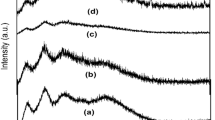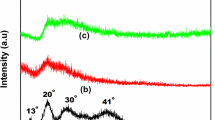Abstract
Solid polymer electrolytes (SPE) are regarded as key components in electrochemical devices since the ionic conduction has a strong influence on the devices’ performance. Proton-conducting SPEs have been recognized for their suitability in the application of electrochemical devices. Solid polymer electrolytes synthesized with natural polymers have been used as polymer host due to their variant structure, richness in nature, and they are economical and biodegradable. Agar–agar, a biopolymer, extracted from red algae, is used as gelling, stabilizing and encapsulating agent in pharmaceutical and biotechnological industries. It is a mixture of polysaccharides—85% of agarose, a neutral polymer, and 15% of agaropectin, a charged sulphated polymer. It has good film-forming tendency. In the present study, proton-conducting biopolymer electrolytes containing agar and ammonium iodide (NH4I) were prepared by solution casting technique. Fourier-transformed infrared (FTIR) spectroscopy results revealed that the complexation between agar and NH4I has occurred. X-ray diffraction (XRD) studies demonstrate the amorphous nature of salted biopolymer electrolytes. It has been found that the film of composition 50 mol% agar:50 mol% NH4I is more amorphous than other samples. The ionic conductivity of the prepared polymer electrolytes is found by AC impedance spectroscopy analysis. The maximum ionic conductivity is 1.17 × 10−4 S cm−1 at ambient temperature for the film of composition 50 mol% agar: 50 mol% NH4I. All electrolytes exhibit Arrhenius behaviour. The frequency dependence of dielectric and electric modulus of agar–ammonium iodide (NH4I) polymer electrolyte is investigated.









Similar content being viewed by others
References
Vijaya N, Selvasekarapandian S, Hirankumar G, Karthikeyan S, Nithya H, Ramya CS, Prabu M (2012) Structural, vibrational, thermal, and conductivity studies on proton-conducting polymer electrolyte based on poly(N-vinylpyrrolidone). Ionics 18:91–99. doi:10.1007/s11581-011-0589-4
Wang A, Bao Y, Weng Z, Huang Z (2008) Synthesis and Characterization of proton-conducting polymer electrolytes based on acrylonitrile-styrene sulfonic acid copolymer/layered double hydroxides nanocomposites. Chin J Chem Eng 16(6):938–943
Ashwin Kumar A, Karthick K, Arumugam KP (2011) Biodegradable polymers and its applications. Int J Biosci Biochem Bioinform 1(3):173-176
Cooke D, Gidley MJ, Hedges ND (1996) Thermal properties of polysaccharides at low moisture. J Therm Anal 47:1485–1498
Guerrero P, Etxabide A, Leceta I, Penalba M, de la Caba K (2014) Extraction of agar from Gelidium sesquipedale (Rodhopyta) and surface characterization of agar based films. Carbohydr Polym 99:491–498
Raphael E, Avellaneda CO, Manzolli B, Pawlicka A (2010) Agar-based films for application as polymer electrolytes. Electrochim Acta 55:1455–1459
Leones R, Sentanin F, Rodrigues LC, Marrucho IM, Esperança JMSS, Pawlicka A, Silva MM (2012) Investigation of polymer electrolytes based on agar and ionic liquids. Express Polym Lett 6(12):1007–1016
Nwanya AC, Amaechi CI, Udounwa AE, Osuji RU, Maaza M, Ezema FI (2015) Complex impedance and conductivity of agar-based ion-conducting polymer electrolytes. Appl Phys A Mater Sci Process 119:387–396
Raphael E, Avellaneda CO, Aegerter MA, Silva MM, Pawlicka A (2012) Agar-based gel electrolyte for electrochromic device application. Mol Cryst and Liq Cryst 554(1):264–272
Nithya S, Selvasekarapandian S, Premalatha M (2016) Synthesis and characterization of proton-conducting polymer electrolyte based on polyacrylonitrile (PAN). Ionics. doi:10.1007/s11581-016-1841-8
Kumar M, Tiwari T, Srivastava N (2012) Electrical transport behaviour of bio-polymer electrolyte system: Potato starch +ammonium iodide. Carbohydr Polym 88:54–60
Audeh DJSA, Alcázar JB, Barbosa CV, Carreño NLV, Avellaneda CAO, Pawlicka AJ, Raphael E (2014) Influence of the NiO nanoparticles on the ionic conductivity of the Agar-based electrolyte. Polímeros, 24, número especial, 8–12
Hodge RM, Edward GH, Simon GP (1996) Water absorption and states of water in semicrystalline poly(vinyl alcohol) films. Polymer 37:1371–1376
El-Hefian EA, Nasef MM, Yahaya AH (2012) Preparation and Characterization of Chitosan/Agar Blended Films: Part 1. Chemical Structure and Morphology. E-J Chem 9(3):1431–1439
Orduña-Rojasa J, Robledoa D (2002) Bot Mar 45:459–464
Bhuvaneswari MS, Selvasekarapandian S, Hirankumar G, Baskaran R, Vijaya kumar M (2005) Ionic conductivity studies on Sr stabilized zirconia by impedance spectroscopy. Ionics 11(5–6):362–365
Jacob MME, Prabaharan SRS, Radhakrishna S (1997) Effect of PEO addition on the electrolytic and thermal properties of PVDF-LiClO4 polymer electrolytes. Solid State Ionics 104:267
Helan Flora X, Ulaganathan R and Rajendran S (2012) Influence of Lithium Salt Concentration on PAN-PMMA Blend Polymer Electrolytes. Int J Electrochem Sci 7:7451–7462
Hirankumar G, Selvasekarapandian S, Bhuvaneswari MS, Baskaran R, Vijayakumar M (2006) Thermal, electrical and optical studies on the poly(vinyl alcohol) based polymer electrolytes. J Solid State Electrochem 10:193–197
MacCallum J.R., Vincent C.A, (1997) Polymer electrolyte review-2 43
Shukla N, Thakur AK, Shukla A, Marx DT (2014) Ion conduction mechanism in solid polymer electrolyte: an applicability of Almond–West formalism. Int J Electrochem Sci 9:7644–7659
Ramesh S, Arof AK (2001) Ionic conductivity studies of plasticized poly(vinyl chloride) polymer electrolytes Mater Sci Eng B 85:11
Author information
Authors and Affiliations
Corresponding author
Rights and permissions
About this article
Cite this article
Selvalakshmi, S., Mathavan, T., Selvasekarapandian, S. et al. Study on NH4I composition effect in agar–agar-based biopolymer electrolyte. Ionics 23, 2791–2797 (2017). https://doi.org/10.1007/s11581-016-1952-2
Received:
Revised:
Accepted:
Published:
Issue Date:
DOI: https://doi.org/10.1007/s11581-016-1952-2




